
A lone tree in the ultramafic maquis, iNaturalist observation 38141863 [Joey Santore, 2020.01.31]

An old but vigorous tree in the ultramafic maquis, with a considerable mass of fallen foliage and cones; iNaturalist observation 38141863 [Joey Santore, 2020.01.31]

A vigorous tree bearing numerous cones, elev. 550 m; iNaturalist observation 38346180 [Joey Santore, 2020.02.03]
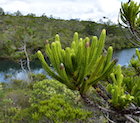
Foliage and pollen cones on tree in habitat, iNaturalist observation 38141863 [Joey Santore, 2020.01.31]
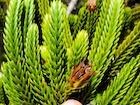
Adult foliage and a mature seed cone, iNaturalist observation 38346180 [Joey Santore, 2020.02.03]
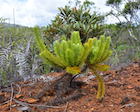
Juvenile foliage on a young sapling, iNaturalist observation 38141863 [Joey Santore, 2020.01.31]
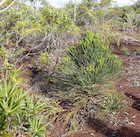
A sapling in the ultramafic maquis, iNaturalist observation 18126719 [Valentin de Mazancourt, 2016.09.03]

A gnarled mature tree [Adam Black, 2020.02.01, Facebook post].

Tree near the river [Adam Black, 2020.02.01, Facebook post].

Adult foliage [Adam Black, 2020.02.01, Facebook post].
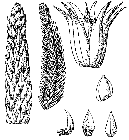
(4) Tip of branchlet with terminal pollen cone; (3) tip of branchlet bearing intermediate foliage; (6) seed cone; (7) seed; (5) lateral, internal and dorsal views of a microsporophyll (de Laubenfels 1972).

Video on New Caledonia vegetation; C. pancheri (as Neocallitropsis), growing at the Chutes de Madeline, is featured extensively, starting at 00:00 and again at 32:15 and 35:25 [Crime Pays But Botany Doesn't 2020.02.02].

Callitris pancheri
(Carrière) Byng 2015
Common names
None seem to have been recorded; it could be called Pancher's cypress-pine.
Taxonomic notes
This taxon continues to be widely known as the sole species in Neocallitropsis Florin 1931 (syn: Callitropsis Compton). Its foliage and especially its cones bear very little resemblance to those of Callitris as generally understood. It seemed an anomaly when Pye et al. (2003) performed an ITS sequence analysis indicating that this species is sister to C. sulcata in a clade embedded within other taxa of both Callitris and Actinostrobus. However, this result was later supported in the analysis of Larter et al. (2017) using a new analysis of available GenBank sequences. Their analysis produced substantially the same phylogenetic tree as Pye et al. (2003), and further indicated the sister relationship with C. sulcata dates to only about 5 ma ago, with the New Caledonian clade having diverged about 30 ma ago. This is certainly the most evidently anomalous of all the species of Callitris, so it's appropriate that it grows in New Caledonia, where extremely strange-looking gymnosperms are the norm.
Synonymy:
- Eutacta pancheri Carrière 1876,
- Callitropsis araucarioides Compton,
- Neocallitropsis araucarioides (Compton) Florin 1944,
- Neocallitropsis pancheri (Carrière) de Laubenfels 1972.
Holotype : Vieillard 1274 (P).
Description
Dioecious trees 2-10m tall, often with a candelabra-shaped crown with the upper branches partly recumbent toward the sun. Bark more or less smooth with long furrows, exfoliating in thin, fibrous bands, brown to dark brown, changing to gray with age. Juvenile leaves lanceolate, sharp, concave on the upper side, with a carina on the back, spreading, 8-14 × 0.8 mm, changing gradually into a strong transitional form. Transitional leaves 6-15 × 1.8-2.5 mm, curved toward the top, changing into adult leaves. Adult leaves slightly spreading and more or less imbricate, lanceolate, sharp, with a strong dorsal carina and concave on the upper side, 4-5 × 2 mm. Pollen cone terminal, globular, 8-10 × 6 mm; microsporophylls acuminate and thorny, reaching a size of 3 × 3 mm at the base of the cone but much smaller toward the top. Seed cone terminal, often on a very short shoot, 10 × 8 mm, having 8 scales with the rostrum spreading on the top, partially covered by the accompanying leaves underneath, greatly unfolds when the cone is ripe. Cone scales linear, about 6-7 mm long × 2mm wide without counting the rostrum parts, rectangular in a transversal cross section, 1-4 ripe seeds per cone. Seed about 6 × 2 mm, with a wing of 0.6 mm. Wood has a strong odor of camphor (de Laubenfels 1972).
Distribution and Ecology
New Caledonia. This tree is only found in small, scattered populations along the many rivers, especially in the southern part of the main island and along the ridges of Pic Buse on the southern flanks of Mt. des Sources at low altitudes and up to 950m above sea level. It grows in the middle maquis (see Gymnosperms of New Caledonia for a description) on serpentine. The pedomorphic form is comparable to that of Dacrydium guillauminii with which it is often associated; it is an adaptation to serpentine. The candelabra form is also characteristic of trees growing in serpentine soils, like Callitris neocaledonica Dummer (1914), another allied species (de Laubenfels 1972).
This map shows herbarium records of Callitris species native to New Caledonia. Red is C. neocaledonica, yellow is C. pancheri, and green is C. sulcata. Click on an icon for further information. Distribution data from GBIF (2020.03.30), edited to remove duplicates.
This species was formerly listed as "Endangered" by the IUCN), but is now not assessed. No reason is given.
Zone 10 (cold hardiness limit between -1°C and +4.4°C) (Bannister and Neuner 2001).
Remarkable Specimens
No data as of 2023.03.03.
Ethnobotany
Observations
De Laubenfels (1972) reports collections from the following locales:
- Lac en Huit
- Madeleine, R. Madeleine and Mine Madeleine (150 m elev.)
- Mt. des Sources (740 m elev.)
- Mts. de Yatè
- Pic Buse (700-950 m elev.)
- Plaine des Lacs
- R. des Lacs (150-240 m elev.)
- R. du Carènage (250 m elev.)
- valley of Prony
Remarks
The epithet remembers French botanist Jean A. I. Pancher (1814-1877), who spent much of his working life in New Caledonia; he is also remembered in Acmopyle pancheri.
Citations
Byng, J. W. 2015. The Gymnosperms Handbook: A practical guide to extant families and genera of the world. Plant Gateway Ltd.
Compton. 1922. Journal of the Linnaean Society 45:433. pl. 27.
Florin. 1944. Palaeontographica 1:35, Abt. B. 590.
Larter, M., S. Pfautsch, J.-C. Domec, S. Trueba, N. Nagalingum, and S. Delzon. 2017. Aridity drove the evolution of extreme embolism resistance and the radiation of conifer genus Callitris. New Phytologist 215:97-112.
Pye, M. G., P. A. Gadek, and K. J. Edwards. 2003. Divergence, diversity and species of the Australasian Callitris (Cupressaceae) and allied genera : Evidence from ITS sequence data. Australian Systematic Botany 16:505–14.
Thanks to Ferenc Kiss for translating de Laubenfels from the French (2003.11).
See also
Association Endemia, a site devoted to New Caledonian species. Has excellent photos, a range map, and other information. In French.
The species account at Threatened Conifers of the World.
Farjon (2005) provides a detailed account, with illustrations.












